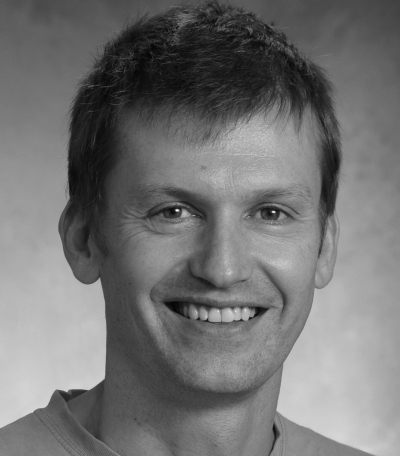
If you want to know how a physicist thinks about the brain, talking to Nicolas Brunel is a good place to start. Brunel, who joined the Duke faculty in July as a professor of neurobiology and physics, uses the tools of statistical physics to illuminate the workings of the brain’s neural networks.
Synapses in our brains change every time we learn something. As pathways and patterns are created in the neural network, some synapses become stronger and others weaker. “What are the rules that govern synaptic plasticity?” Brunel asks. “What are the physical phenomena that are happening there? How do changes in individual synapses change the behavior of the whole network?” To study these questions, Brunel creates statistical models that grew out of using models originally designed by physicists to help explain the behavior of spinning electrons.
“To describe a network of neurons,” he says, “you need to describe the matrix of interactions between these neurons, which is analogous to a matrix of interactions between spins.”
Brunel published a paper last year describing a model network of neurons and the synapses that connect them. He created the model to investigate learning in the cerebral cortex, the large outer layer of the mammalian brain that perceives, thinks, and processes language. After the model had stored (“learned”) the maximum number of patterns, Brunel found that the resulting synaptic network reproduced features that have been shown experimentally to exist in animal brains.
Brunel found that overall connectivity was not uniform post-learning. Most potential synapses were not activated. Among neurons that were synaptically connected, some were connected unidirectionally (information flowing in one direction from one neuron to another) and some bidirectionally (flowing in both directions between two neurons). Bidirectional pairings were overrepresented compared to a random network. The strength of those synapses was stronger on average than unidirectional pairs—consistent with the long-standing experimental observation that “neurons that fire together, wire together.” Animal experiments have also shown sparseness of connectivity and overrepresentation of bidirectional pairings.
“The interesting point here is to connect some high level principles about information storage with some very basic experimental numbers about pairs of neurons,” Brunel says.
“Nicolas is a world authority in applying certain areas of theoretical physics to understanding certain properties of brains,” says Henry Greenside, professor of physics. “Brains are exceedingly complicated physical objects; they are so intricate that brute-force experimental study is not sufficient to understand the principles upon which they work. Nicolas has played an important role in providing a conceptual concept to think about brains.”
Brunel is co-directing the new Center of Theoretical Neurobiology in the Bryan Research Building with Jeff Beck, a mathematician and assistant professor in the departments of neurobiology, electrical and computer engineering, and biomedical engineering. Beck says, “People have really begun to recognize the power of using rigorous physics models to investigate the brain. Taking that approach has done a great deal for neuroscience in the last 20 years and Nicolas has been a good part of that.”
In addition to supporting theoretical neuroscience modeling and research, the Center will welcome neuroscience graduate students, postdocs, faculty, and others who have loads of data and need help getting up to speed on the most sophisticated data analysis tools available. “The Center is really going to up everyone’s game in the Duke neuroscience community in terms of analytic rigor and modern statistical methods,” Beck says. “Nicolas and I want to have an open-door policy where anyone who says, ‘I’ve got this data what should I do with it?’ can swing by, have a seat and we’ll hash it out.”
The wealth of new data in neuroscience gives model-makers like Brunel checkpoints they can use to constrain and inform their models. “We can ask questions now we were not able to ask five or 10 years ago,” Brunel says. “It’s a really good time to work in this field.”
When he’s not thinking about brains, Brunel likes to spend time with his family riding bikes and playing soccer. A native of Rennes, France, Brunel came to Duke from the University of Chicago. His wife, Susana Caviglia, is an assistant professor in Duke’s department of art, art history, and visual studies. They have three children: a twelve-year-old and nine-year-old twins. The family lives in Chapel Hill, where the children are enjoying the novelty of having a house and a backyard after years of city life in Paris and Chicago.
One of the things that drew Brunel to Duke is the opportunity for interdisciplinary collaboration and the interest in neuroscience across many departments. “To really go forward in neuroscience now, we need to bring together people with different and complementary tools,” Brunel says. “Duke is one of the few locations where you have all these different groups of people collaborating.”
Greenside predicts many faculty members will be interested in working with Brunel, and is looking forward to doing so himself. “Nicolas brings a missing expertise on campus—a deep knowledge of how to apply the physics of many interacting objects to brains,” he says. “And it’s not just brains—he’s an expert in statistical physics and that overlaps with many areas of biophysics and condensed matter physics. He’ll be considered a very stimulating colleague to have.”
Mary-Russell Roberson is a freelance science writer who lives in Durham.
Dr. Brunel was also featured in the DukeToday story "A Quantitative Investment in Promoting the Sciences at Duke." Read it here.